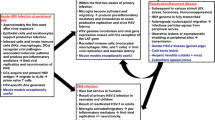Summary
Thein vitro cytopathology and the neurovirulence to inbred mice demonstrated by five variants originally derived from one laboratory strain (Miyama) of type I herpes simplex virus (HSV-1) were studied comparatively. Three of the variants are syncytial [+GC (LPV), +GC (SPV), +GC (81)] and two are non-syncytial [−GCr and −GCf]. The size of plaques produced by the five variants was found to be in the order of +GC (LPV)>+GC (81)>+GC (SPV)>−GCf>−GCr. The pathogenicity of these variants was compared in three kinds of inbred mice (AKR, C 3 H/He and C 57 BL) after intraperitoneal (IP) or intracerebral (IC) inoculation. The +GC (LPV) variant was the most virulent as shown by the highest mortality of mice by either route of inoculation. The other four variants caused death of mice only after IC inoculation, and among these variants, +GC (81) was shown to be the most virulent. These data indicate that so far as these five variants of the Miyama strain of HSV-1 are concerned, neurovirulence is positively correlated with their cell fusion activity or the size of plaques which they produce. Pre-IP-inoculation with any of the less virulent variants [−GCr, +GC (SPV) and +GC (81)] protected mice from subsequent lethal infection with +GC (LPV) by the same route of inoculation.
Similar content being viewed by others
References
Dix, R. D., McKendall, R. R., Baringer, J. R.: Comparative neurovirulence of herpes simplex virus type 1 strains after peripheral or intracerebral inoculation of BALB/c mice. Infect. Immun.40, 103–112 (1983).
Hoggan, M. D., Roizman, B.: The isolation and properties of a variant of herpes simplex producing multinucleated giant cells in monolayer cultures in the presence of antibody. Am. J. Hyg.70, 208–219 (1959).
Levitan, D. B., Blough, H. A.: Preliminary biochemical characterization of the factor(s) responsible for herpesvirus-induced exogenous fusion. J. Virol.18, 1081–1087 (1976).
Lopez, C.: Genetics of natural resistance to herpesvirus infection in mice. Nature258, 152–153 (1975).
Lopez, C.: Genetics of the host in herpesvirus infections. In:Nahmias, A. J., Dowdle, W. R., Shinazi, R. F. (eds.), The Human Herpesviruses, 121–131. New York: Elsevier 1981.
Nii, S.: The difference in the cytopathic changes in FL cells infected with different strains of herpes simplex virus. Biken J.4, 215–216 (1961).
Nii, S.: Plaque formation by three variants of the Miyama strain of herpes simplex virus. Biken J.12, 251–255 (1969).
Nii, S.: Rapid variation of a freshly isolated strain of herpes simplex virus. Biken J.15, 99–103 (1972).
Nii, S., Kamahora, J.: Studies on the growth of a newly isolated herpes simplex virusin vitro. Biken J.4, 75–96 (1961).
Nii, S., Kamahora, J.: Cytopathic changes induced by herpes simplex virus. Biken J.4, 255–270 (1961).
Nii, S., Yamada, M., Uno, F.: Giant cell-forming variants of the Miyama strain of type I herpes simplex virus which differ in fusion activity. Biken J.26, 127–131 (1983).
Poste, G., Pasternak, A.: Virus-induced cell fusion. In:Poste, G., Nicolson, G. L. (eds.), Membrane fusion (Cell surface reviews Vol. 5), 305–367. Amsterdam-New York-Oxford: North-Holland Publishing Co. 1978.
Reed, L. J., Muench, H.: A simple method of estimating fifty per cent endpoints. Am. J. Hyg.27, 493–497 (1938).
Richards, J. T., Kern, E. R., Overall, Jr., J. C., Glasgow, L. A.: Differences in neurovirulence among isolates of herpes simplex virus types 1 and 2 in mice using four routes of infection. J. Infect. Dis.144, 464–471 (1981).
Schröder, C. H., Engler, H., Kirchner, H.: Protection of mice by an apathogenic strain of HSV-1 against lethal infection by a pathogenic strain of HSV-1. J. gen. Virol.52, 159–161 (1981).
Shimizu, F., Satoh, J., Tada, M., Kumagai, K.: Suppression ofin vitro growth of virulent and avirulent herpes simplex viruses by cell-mediated immune mechanisms, antibody and interferon. Infect. Immun.22, 752–757 (1978).
Spear, P. G.: Membrane proteins specified by herpes simplex viruses. I. Identification of four glycoprotein precursors and their products in type 1-infected cells. J. Virol.17, 991–1008 (1976).
Thompson, R. L., Stevens, J. G.: Biological characterization of a herpes simplex virus intertypic recombinant which is completely and specifically non-neurovirulent. Virology131, 171–179 (1983).
Thompson, R. L., Wagner, E. K., Stevens, J. G.: Physical location of a herpes simplex virus type-1 gene function(s) specifically associated with a 10 million-fold increase in HSV neurovirulence. Virology131, 180–192 (1983).
Tokumaru, T.: The nature of toxins of herpes simplex virus. I. Syncytial giant cell producing components in tissue culture. Arch. ges. Virusforsch.24, 104–122 (1968).
Wheeler, Jr., C. E.: Biologic comparison of a syncytial and a small giant cell-forming strain of herpes simplex. J. Immunol.93, 749–756 (1964).
Yoshino, K., Taniguchi, S.: Isolation of a clone of herpes simplex virus highly attenuated for newborn mice and hamsters. Jpn. J. Exp. Med.39, 223–232 (1969).
Author information
Authors and Affiliations
Additional information
With 4 Figures
Rights and permissions
About this article
Cite this article
Yamada, M., Uno, F. & Nii, S. In vitro cytopathology and pathogenicity to inbred mice shown by five variants of a laboratory strain of type 1 herpes simplex virus. Archives of Virology 90, 183–196 (1986). https://doi.org/10.1007/BF01317369
Received:
Accepted:
Issue Date:
DOI: https://doi.org/10.1007/BF01317369




